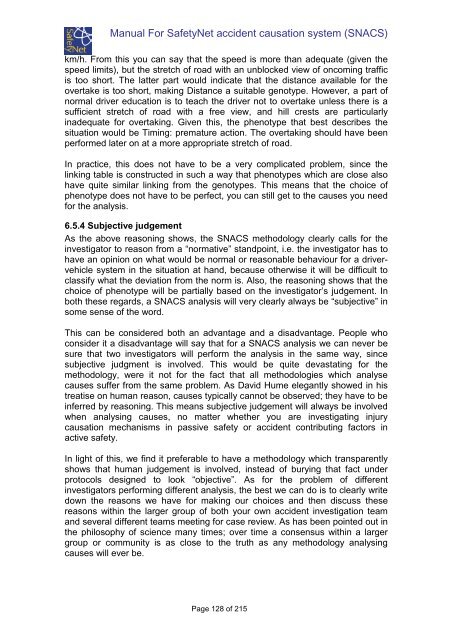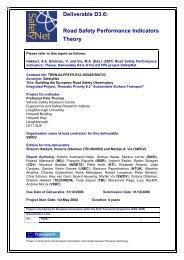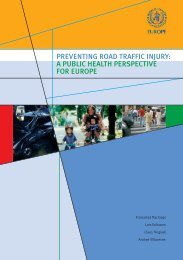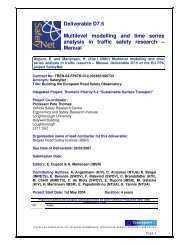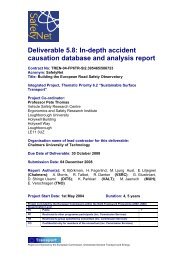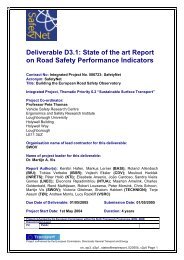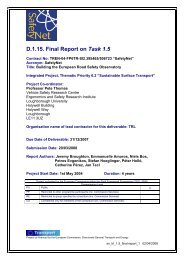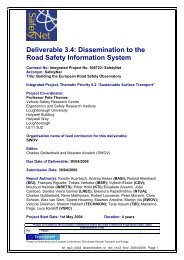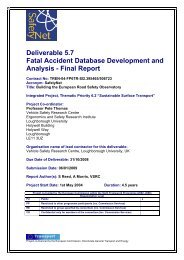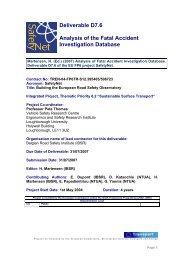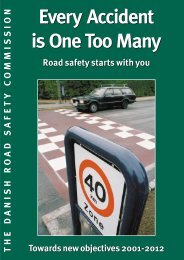Glossary of Data Variables for Fatal and accident causation ... - ERSO
Glossary of Data Variables for Fatal and accident causation ... - ERSO
Glossary of Data Variables for Fatal and accident causation ... - ERSO
Create successful ePaper yourself
Turn your PDF publications into a flip-book with our unique Google optimized e-Paper software.
Manual For SafetyNet <strong>accident</strong> <strong>causation</strong> system (SNACS)<br />
km/h. From this you can say that the speed is more than adequate (given the<br />
speed limits), but the stretch <strong>of</strong> road with an unblocked view <strong>of</strong> oncoming traffic<br />
is too short. The latter part would indicate that the distance available <strong>for</strong> the<br />
overtake is too short, making Distance a suitable genotype. However, a part <strong>of</strong><br />
normal driver education is to teach the driver not to overtake unless there is a<br />
sufficient stretch <strong>of</strong> road with a free view, <strong>and</strong> hill crests are particularly<br />
inadequate <strong>for</strong> overtaking. Given this, the phenotype that best describes the<br />
situation would be Timing: premature action. The overtaking should have been<br />
per<strong>for</strong>med later on at a more appropriate stretch <strong>of</strong> road.<br />
In practice, this does not have to be a very complicated problem, since the<br />
linking table is constructed in such a way that phenotypes which are close also<br />
have quite similar linking from the genotypes. This means that the choice <strong>of</strong><br />
phenotype does not have to be perfect, you can still get to the causes you need<br />
<strong>for</strong> the analysis.<br />
6.5.4 Subjective judgement<br />
As the above reasoning shows, the SNACS methodology clearly calls <strong>for</strong> the<br />
investigator to reason from a “normative” st<strong>and</strong>point, i.e. the investigator has to<br />
have an opinion on what would be normal or reasonable behaviour <strong>for</strong> a drivervehicle<br />
system in the situation at h<strong>and</strong>, because otherwise it will be difficult to<br />
classify what the deviation from the norm is. Also, the reasoning shows that the<br />
choice <strong>of</strong> phenotype will be partially based on the investigator’s judgement. In<br />
both these regards, a SNACS analysis will very clearly always be “subjective” in<br />
some sense <strong>of</strong> the word.<br />
This can be considered both an advantage <strong>and</strong> a disadvantage. People who<br />
consider it a disadvantage will say that <strong>for</strong> a SNACS analysis we can never be<br />
sure that two investigators will per<strong>for</strong>m the analysis in the same way, since<br />
subjective judgment is involved. This would be quite devastating <strong>for</strong> the<br />
methodology, were it not <strong>for</strong> the fact that all methodologies which analyse<br />
causes suffer from the same problem. As David Hume elegantly showed in his<br />
treatise on human reason, causes typically cannot be observed; they have to be<br />
inferred by reasoning. This means subjective judgement will always be involved<br />
when analysing causes, no matter whether you are investigating injury<br />
<strong>causation</strong> mechanisms in passive safety or <strong>accident</strong> contributing factors in<br />
active safety.<br />
In light <strong>of</strong> this, we find it preferable to have a methodology which transparently<br />
shows that human judgement is involved, instead <strong>of</strong> burying that fact under<br />
protocols designed to look “objective”. As <strong>for</strong> the problem <strong>of</strong> different<br />
investigators per<strong>for</strong>ming different analysis, the best we can do is to clearly write<br />
down the reasons we have <strong>for</strong> making our choices <strong>and</strong> then discuss these<br />
reasons within the larger group <strong>of</strong> both your own <strong>accident</strong> investigation team<br />
<strong>and</strong> several different teams meeting <strong>for</strong> case review. As has been pointed out in<br />
the philosophy <strong>of</strong> science many times; over time a consensus within a larger<br />
group or community is as close to the truth as any methodology analysing<br />
causes will ever be.<br />
Page 128 <strong>of</strong> 215


